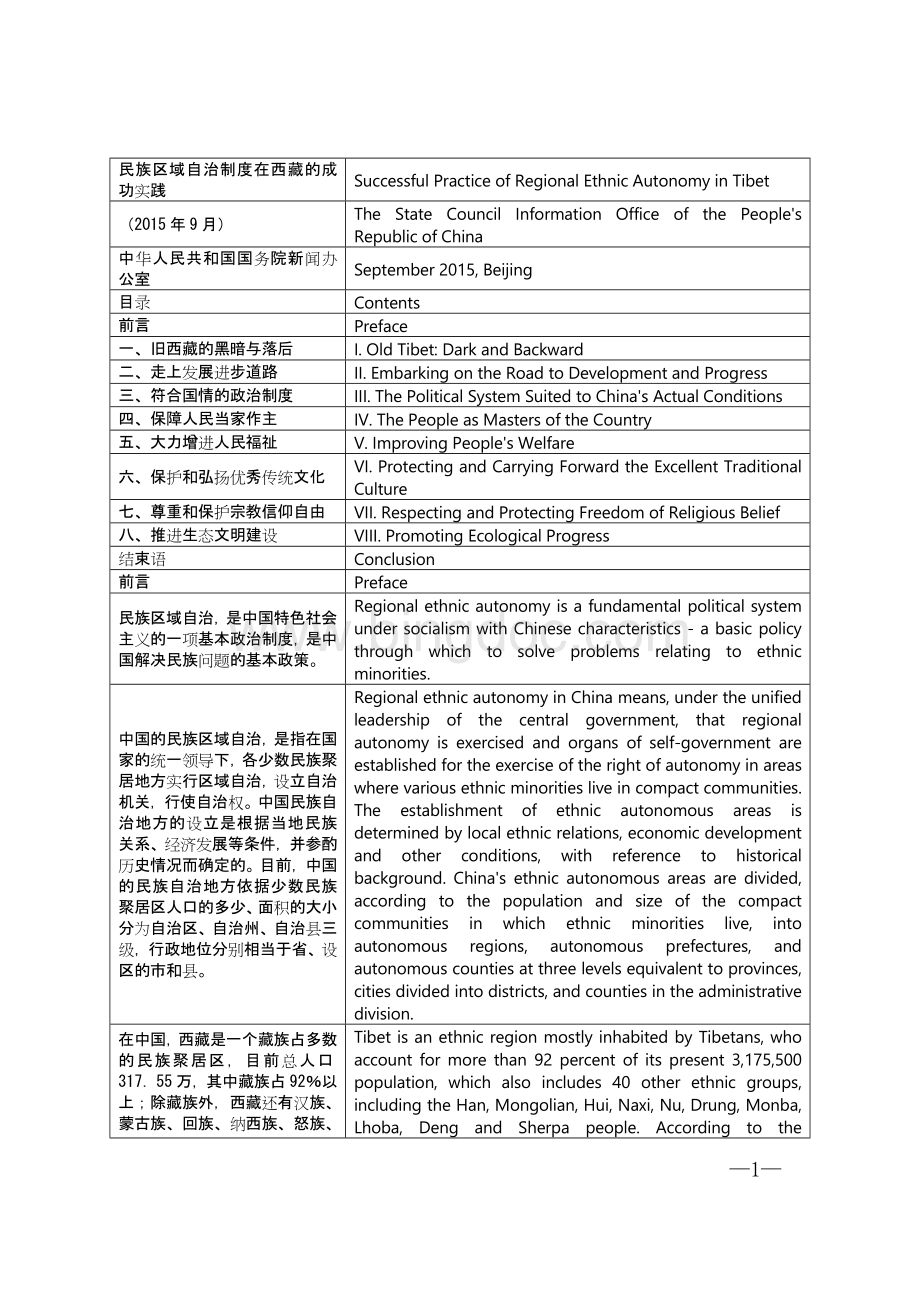白皮书-民族区域自治制度在西藏的成功实践(中英文对照).doc
《白皮书-民族区域自治制度在西藏的成功实践(中英文对照).doc》由会员分享,可在线阅读,更多相关《白皮书-民族区域自治制度在西藏的成功实践(中英文对照).doc(41页珍藏版)》请在冰点文库上搜索。

民族区域自治制度在西藏的成功实践
SuccessfulPracticeofRegionalEthnicAutonomyinTibet
(2015年9月)
TheStateCouncilInformationOfficeofthePeople'sRepublicofChina
中华人民共和国国务院新闻办公室
September2015,Beijing
目录
Contents
前言
Preface
一、旧西藏的黑暗与落后
I.OldTibet:
DarkandBackward
二、走上发展进步道路
II.EmbarkingontheRoadtoDevelopmentandProgress
三、符合国情的政治制度
III.ThePoliticalSystemSuitedtoChina'sActualConditions
四、保障人民当家作主
IV.ThePeopleasMastersoftheCountry
五、大力增进人民福祉
V.ImprovingPeople'sWelfare
六、保护和弘扬优秀传统文化
VI.ProtectingandCarryingForwardtheExcellentTraditionalCulture
七、尊重和保护宗教信仰自由
VII.RespectingandProtectingFreedomofReligiousBelief
八、推进生态文明建设
VIII.PromotingEcologicalProgress
结束语
Conclusion
前言
Preface
民族区域自治,是中国特色社会主义的一项基本政治制度,是中国解决民族问题的基本政策。
RegionalethnicautonomyisafundamentalpoliticalsystemundersocialismwithChinesecharacteristics-abasicpolicythroughwhichtosolveproblemsrelatingtoethnicminorities.
中国的民族区域自治,是指在国家的统一领导下,各少数民族聚居地方实行区域自治,设立自治机关,行使自治权。
中国民族自治地方的设立是根据当地民族关系、经济发展等条件,并参酌历史情况而确定的。
目前,中国的民族自治地方依据少数民族聚居区人口的多少、面积的大小分为自治区、自治州、自治县三级,行政地位分别相当于省、设区的市和县。
RegionalethnicautonomyinChinameans,undertheunifiedleadershipofthecentralgovernment,thatregionalautonomyisexercisedandorgansofself-governmentareestablishedfortheexerciseoftherightofautonomyinareaswherevariousethnicminoritiesliveincompactcommunities.Theestablishmentofethnicautonomousareasisdeterminedbylocalethnicrelations,economicdevelopmentandotherconditions,withreferencetohistoricalbackground.China'sethnicautonomousareasaredivided,accordingtothepopulationandsizeofthecompactcommunitiesinwhichethnicminoritieslive,intoautonomousregions,autonomousprefectures,andautonomouscountiesatthreelevelsequivalenttoprovinces,citiesdividedintodistricts,andcountiesintheadministrativedivision.
在中国,西藏是一个藏族占多数的民族聚居区,目前总人口317.55万,其中藏族占92%以上;除藏族外,西藏还有汉族、蒙古族、回族、纳西族、怒族、独龙族、门巴族、珞巴族以及僜人、夏尔巴人等40多个民族成分。
根据中国宪法,国家在西藏实行民族区域自治制度,建立西藏自治区,并设有门巴、珞巴、纳西等民族乡,依法保障西藏各族人民平等参与管理国家和地方事务的政治权利。
TibetisanethnicregionmostlyinhabitedbyTibetans,whoaccountformorethan92percentofitspresent3,175,500population,whichalsoincludes40otherethnicgroups,includingtheHan,Mongolian,Hui,Naxi,Nu,Drung,Monba,Lhoba,DengandSherpapeople.AccordingtotheConstitutionofthePeople'sRepublicofChina(PRC),regionalethnicautonomyhasbeenexercisedinTibet,andTibetAutonomousRegion,underwhicharetheMonba,LhobaandNaxiethnictownships,hasbeenfounded,protectingbylawthepoliticalrightsofvariousethnicgroupsinTibettoparticipateasequalsinadministeringstateandlocalaffairs.
自1959年实行民主改革和1965年实行民族区域自治制度以来,西藏不仅建立起全新的社会主义制度,而且实现了经济社会发展的历史性跨越。
西藏成功地走上了与全国各族人民共同团结奋斗、共同平等发展、共同繁荣进步的光明大道。
藏民族作为中华民族大家庭的一员,实现了平等参与管理国家事务的权利,成为管理西藏地方社会事务、主宰自己命运的主人,成为西藏社会物质财富、精神财富的创造者和享有者。
Sincethedemocraticreformwascarriedoutin1959andregionalethnicautonomycameintopracticein1965,Tibethasestablishedthenewsocialistsystemandachievedhistoricleapsandboundsinitseconomicandsocialdevelopment.TibethastakenaroadthatunitesitwithallChina'sethnicgroupsandstrugglestodevelopequally,achieveprosperity,andmakeprogresswiththem.AspartoftheChinesenation,theTibetanpeoplefulfilltherighttoparticipateequallyinthemanagementofstateaffairs;theyarethusmanagersoflocalsocialaffairsandmastersoftheirowndestiny,creatingandsharingthematerialandspiritualwealthofTibet.
虽然西藏自治区从成立至今只有50年,但带来了翻天覆地的巨大变化。
今日的西藏,是其历史上最为辉煌的时期。
Althoughithasbeenonly50yearssincethefoundingofTibetAutonomousRegion,greatchangeshavetakenplace.Tibetisnowinitsgoldenage.
一、旧西藏的黑暗与落后
I.OldTibet:
DarkandBackward
直至20世纪50年代,西藏社会依然处于政教合一的封建农奴制统治之下。
这种存在了几百年的黑暗制度,扼杀人权,摧残人性,是人类社会最为落后的制度。
在这种制度下,人民既无民主权利,也无经济、社会、文化权利,各项基本人权根本得不到保障。
旧西藏与现代文明的距离,十分遥远。
Eveninthe1950s,Tibetwasstillasocietyruledbyfeudalserfdomundertheocracy.Havingexistedforseveralcenturies,thiswretchedsystemstifledhumanrightsanddestroyedhumanqualities.Itwasthusthemostbackwardmodeofhumansocietyunderwhichthepeoplehadnodemocratic,economic,social,orculturalrights,andtheirbasichumanrightswerenotprotected.OldTibetwasafarcryfrommoderncivilization.
在封建农奴制度统治之下,农奴遭受残酷的政治压迫,没有任何人身自由,丧失了基本人权。
Underfeudalserfdom,serfssufferedcruelpoliticaloppressionandhadnopersonalfreedomorfundamentalrights.
旧西藏实行以《十六法典》《十三法典》为代表的法律,对广大农奴实行野蛮压迫。
这些《法典》将人分成“三等九级”,大贵族、大活佛和高级官员被认为是天生高贵的人,处于最上等地位,而广大农奴则被划为下等人。
命价也有高低不同,上等人“命价为与尸体等重的黄金”,屠夫、铁匠等下等下级的人,“命价仅值一根草绳”。
不同等级的人触犯同一刑律,量刑标准和处置方法也不相同。
仆人使主人受伤的,要砍掉仆人的手或脚;主人打伤仆人,则不付给任何赔偿费。
农奴主和农奴在法律上的地位极其不平等,农奴主拥有对农奴和奴隶的生杀予夺权,他们用剜目、割肉、割舌、断手、剁脚、抽筋、戴铐等野蛮刑罚,来维护对农奴和奴隶的统治。
OldTibetimplementedlaws,asrepresentedbythe"16-ArticleCode"and"13-ArticleCode,"thatoppressedserfs.Theselawsdividedpeopleintothreeclassesandnineranks,wherebynobles,LivingBuddhasandseniorofficialswerebornintoandthusconstitutedtheupperclass,whilethebroadmassesofserfsconstitutedthelowerclass.Valueaccordedtolifecorrespondinglydiffered.Thevalueofthelifeofapersonoftheupperclasswasmeasuredingoldaccordingtohisweight.Thevalueofthelivesofbutchers,blacksmiths,andothersofthelowestrankofthelowerclasswasequivalenttohempenrope.Whenpeopleofdifferentclassesandranksviolatedthesamecriminallaw,thecriteriainoldTibetforimposingpenaltiesandthemeansofpunishmentwerequitedifferent.Thelawsstipulatedthatthepunishmentforaservantwhoinjuredhismasterwastohavehishandsorfeetchoppedoff,butamasterwhoinjuredaservantwasnotrequiredtopaycompensation.Serfownersandserfshadovertlyunequalstandingaccordingtolaw.Serfownersheldabsolutepoweroverthelivesofserfsandslaves,andensuredtheirruleoverthelatterthroughsavagepunishments,includinggougingouteyes,cuttingoutfleshortongues,cuttingoffhandsorfeet,pullingouttendons,andbeingputinmanacles.
旧西藏的噶厦政府规定,农奴只能固定在所属领主的庄园土地上,不得擅自离开,绝对禁止逃亡。
“人不无主、地不无差”,三大领主强制占有农奴人身,农奴世世代代依附领主,作为土地的附属物束缚在土地上。
凡是人力和畜力能种地的,一律得种差地,并支乌拉差役。
农奴一旦丧失劳动能力,就收回牲畜、农具、差地,降为奴隶。
三大领主还把农奴当作私有财产随意支配,用于赌博、抵债、赠送、转让和买卖。
农奴的婚姻必须取得领主的同意,不同领主的农奴婚嫁要缴纳“赎身费”。
农奴生小孩要到领主那里缴纳出生税,登记入册,注定终身为奴。
农奴如果被迫流落外地谋生,要向原属领主交“人役税”,持交税证明,才不至于被当作逃亡户处理。
TheKashag(cabinet)ofoldTibetprescribedthatallserfsmuststayonthelandwithinthemanorsoftheirowners.Theywerenotallowedtoleavewithoutpermission;fleeingthemanorwasforbidden."Allserfshaveownersandallplotsoflandareassigned."Serfswerepossessedbythethreemajorestate-holders(localgovernmentofficials,noblesandupper-rankinglamasinmonasteries).Theyremainedserfsfromgenerationtogeneration,andconfinedtothelandoftheirowners.Allserfsandtheirlivestockabletolaborhadtotilltheplotsoflandassignedtothemandprovidecorveelabor.Onceserfslosttheirabilitytolabor,theyweredeprivedoflivestock,farmtoolsandland,andtheirstatuswasdegradedtothatofslave.Sinceserfsweretheirprivateproperty,thethreemajorestate-holderscouldusethemasgamblingstakes,mortgagesfordebt,presentthemasgifts,ortransferandtradethem.Allserfsneededpermissionfromtheirownerstomarry,andmaleandfemaleserfsbelongingtodifferentownershadtopay"redemptionfees"beforesuchpermissionwasgranted.Aftermarriage,serfswerealsotaxedontheirnewbornchildren,whichwereregisteredthemomenttheywereborn,sosealingtheirfateaslifelongserfs.Serfsthatneededtomakealivinginotherplaceswererequiredtopay"servitudetax,"andhadtoproduceproofofhavingpaidsuchtaxortheywouldotherwisebepunishedasfugitives.
1940年前往主持十四世达赖喇嘛坐床的国民政府蒙藏委员会委员长吴忠信在《奉使办理藏事报告书》中,对旧西藏统治者对人民的压迫以及人民的悲惨痛苦处境有这样的描述:
“西藏因地处高寒,农产稀少,人民生活本极困难,而西藏当局压迫剥削更无所不用其极,使藏民生活堕入人间地狱,其苦乃不可言。
西藏当局视人民直如奴隶牛马,照例不付代价,即伙食马料亦须由人民自备,而差徭纷繁几无宁日,人民受扰之剧可以想见。
政府复可一纸命令无代价的征收人民之财产,或将此种财产赏给寺庙或贵族中之有功者。
总之,在西藏境内,人民已失去其生存与自由之保障,其生活之痛苦实非言语所可形容也。
”
Afterpresidingovertheenthronementceremonyofthe14thDalaiLamain1940,WuZhongxin,chiefoftheCommissionforMongolianandTibetanAffairsoftheKuomintangGovernment,describedtherulers'oppressionandthepeople'ssufferingsinoldTibetinhis"ReportonTibetanAffairsonaMission":
"Locatedinfrigidhighlands,Tibethasrareagriculturalproducts.Thepeopleliveahardlife,whereastheTibetanauthoritiesdotheirutmosttooppressandexploitthem,makingthelivesoftheTibetansoneofhellandmisery.TheTibetanauthoritiesregardthepeopleasslavesandbeastsofburdenanddonotpaythemasarule;thepeopleevenhavetofindtheirownfoodandhorsefodder;meanwhiletheyendureincessant,copiousandcomplicatedcorveelaborandneverenjoydaysofpeace.Youcanthusimaginehowharassedtheyare.Theauthoritiescanissueanordertoappropriatethepeople'spropertywithoutcompensationandbestowsuchpropertyonlamaseriesormeritoriousnobles.Inshort,inTibet,thepeoplehavelosttheirguaranteeofsurvivalandfreedom,andtheirmiserablelifeisbeyonddescription."
在封建农奴制度统治之下,农奴没有生产资料,生存权受到严重威胁。
Ruledbyfeudalserfdomundertheocracy,serfshadnomeansofproduction,andtheirrighttosubsistencewasunderthreat.
旧西藏,占人口只有5%的三大领主(官家、贵族、寺庙上层僧侣)及其代理人,几乎占有全部的耕地、牧场、森林、山川、河流、河滩以及大部分牲畜,而占人口多达95%的农奴,包括“差巴”(领种份地,向农奴主支差役的人)、“堆穷”(意为冒烟的小户)、“朗生”(一无所有,世代为奴),却不掌握生产资料,遭受残酷的经济剥削。
InoldTibet,thethreemajorestate-holdersandtheiragentsaccountedforonlyfivepercentofTibet'spopulation,buttheyownedalmostallofTibet'sfarmland,pastures,forests,mountains,rivers,andbeaches,aswellasmostofthelivestock.About95percentofoldTibet'spopulationwasmadeupofserfs,including"tralpa"astheyareknownintheTib